
Looking for How to Freeze Corn on the Cob - Easily! With Step-by-step Photos, Recipe, Directions, Ingredients and Costs in 2025? Scroll down this page and follow the links. And if you bring home some fruit or vegetables and want to can, freeze, make jam, salsa or pickles, see this page for simple, reliable, illustrated canning, freezing or preserving directions. There are plenty of other related resources, click on the resources dropdown above. If you are having a hard time finding canning lids, I've used these, and they're a great price & ship in 2 days.
If you have questions or feedback, please let me know! There are affiliate links on this page. Read our disclosure policy to learn more.
How to Freeze Corn on the Cob - Easily! With Step-by-step Photos, Recipe, Directions, Ingredients and Costs
How to Freeze Corn on the Cob!
Click here for a PDF print version
If you like frozen niblets-type corn in the winter, just imagine how good it would taste if you had picked a couple of dozen ears yourself, or bought a couple dozen fresh ears from a farm stand and then quickly froze it at home! It is also one of the simplest ways to put up a vegetable for the winter. Here's how to do it, complete instructions in easy steps and completely illustrated. The corn will taste MUCH better than anything you've ever had from a store. If you want directions on how to freeze corn cut off the cob (niblets and cream style), click here!
Directions for Freezing Corn on the Cob!
Ingredients
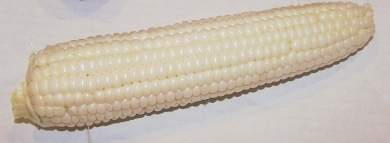
- fresh corn on the cob - any quantity. I figure 1.5 ears per serving. An ideal ear at right - ripe but not bloated. the kernels are still tender (easily punctured with your fingernail) and the juice is milky). White, yellow or bicolor types are all fine!
Equipment
- 1 Large pot of boiling water
- Plenty of ice - about 1 tray per ear.
- Vacuum food sealer or "ziploc" type freezer bags (the freezer bag version is heavier and protects better against freezer burn.
- 2 large bowls, one filled with cold water and ice.
- 1 sharp knife
- 1 Large spoon
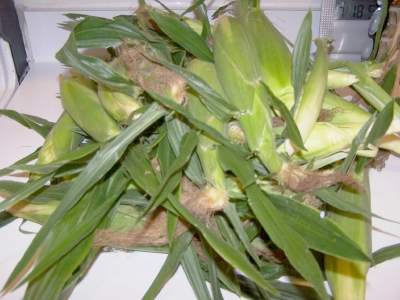
Instructions
Step 1 - Get yer corn!
Start with fresh corn on the cob - as fresh as you can get. If there is a delay between harvesting and freezing, put it in the refrigerator or put ice on it. The sugars break down quickly at room temperature.
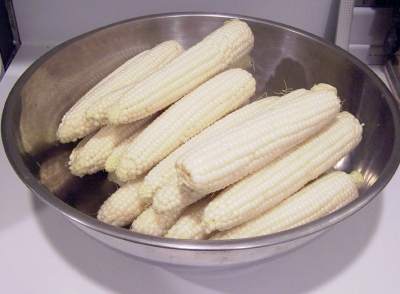
Step 2 - Husk the corn
Husk the corn and pick off as much of the silk as you can. A soft vegetable brush is the fastest and easiest way to get the remaining silk off - just don't be too rough with it.
Step 3 - Ge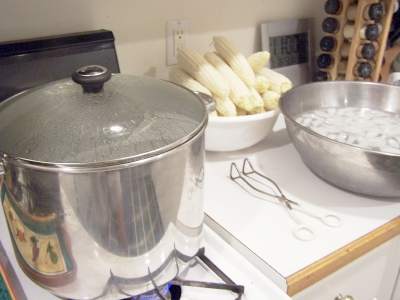 t the pots ready
t the pots ready
Get the largest pot you have (I use my canner) filled 3/4 full with hot water, put it on your largest burner (or straddle two burners) and get it heating to a full rolling boil..
Next, get a LARGE bowl filled with ice and cold water. You may need to buy a bag or two of ice if you are planning to do more than a dozen ears of corn.
Step 4 - Blanch the corn. 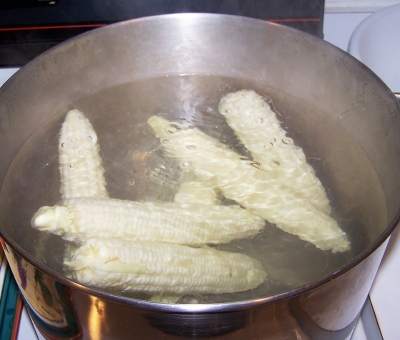
All fruits and vegetables contain enzymes that, over time, break down the destroy nutrients and change the color, flavor, and texture of food during frozen storage. Corn requires a brief heat treatment, called blanching, in boiling water or steam, to destroy the enzymes before freezing. Blanching times generally vary from one to 10 minutes, depending on the vegetable. the duration should be just long enough to stop the action of the enzymes.
Begin counting the blanching time as soon as you place the corn in the boiling water. Cover the kettle and boil at a high temperature for the required length of time. You may use the same blanching water several times (up to 5). Be sure to add more hot water from the tap from time to time to keep the water level at the required height.
Blanching time varies depending on the type of frozen corn you are making: cut-whole kernel, cream style or corn-on-the-cob:
Blanching times, for freezing the corn alsodepend upon the size of the corn cobs, since the heat must penetrate:
Blanching notes:
UC Davis research has shown that super sweet varieties typically require a shorter 2 to 4 min blanch. Their point being, it is easy to OVER-blanch super sweet corn. In my own experience, I've found that blanching for 4 minutes is optimal, if you are going to eat the corn within 3 or 4 months. The blanching step is ONLY to stop the action of enzymes that degrade the flavor - it is not a safety step, so less is better than more in this case! Especially with super sweet varieties - as one farmer (Vaughan Farm's Produce) points out, the sugars can caramelize (breakdown) if you blanch too long.
Some people skip blanching and report excellent results. I still blanch for 4 minutes, and use that as a cleaning step and to slow some enzymes.
USDA Recommended Blanching times for corn-on-the-cob:
- small ears ( 11/4 inches or less in diameter) 7 minutes,
- medium ears (11/4 to 11/2 inches in diameter) 9 minutes, and
- large ears (over 11/2 inches in diameter) 11 minutes.
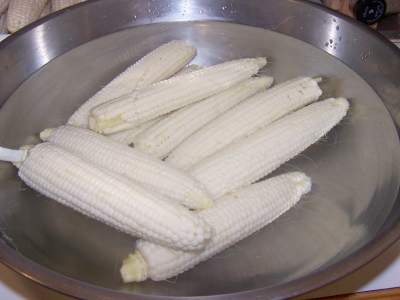
Step 5 - Cool, then drain the corn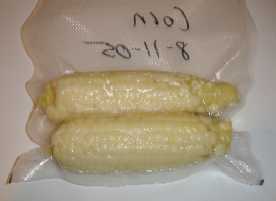
After corn is blanched, cool them quickly to prevent overcooking. Plunge the corn into a large quantity of ice-cold water (I keep adding more ice to it). A good rule of thumb: Cool for the same amount of time as the blanch step. For instance, if you blanch sweet corn for 7 minutes, then cool in ice water for 7 minutes.
Drain thoroughly. 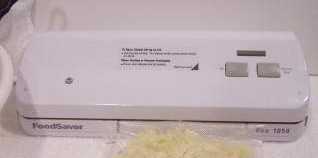
Step 6 - bag the corn
I love the FoodSavers (see this page for more information) with their vacuum sealing! I am not paid by them, but these things really work. If you don't have one, ziploc bags work, too, but it is hard to get as much air out of the bags. remove the air to prevent drying and freezer burn.
A vacuum-sealed FoodSaver bag is on top at left, and a hand-sealed ziploc
bag below it. You can see how the FoodSaver really sucks out all the air, so
the corn won't dry out or get freezer burn. That means the food inside will
last many times longer. I've been using them (and their predecessor in the
marketplace, Seal-a-Meal) for many years.
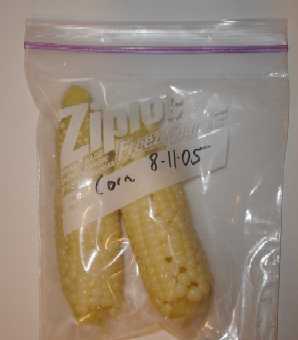 If you're interested,
here's where you can get one.
If you're interested,
here's where you can get one.
If you choose not to vacuum seal, you can almost accomplish the same thing by wrapping each ear with Saran wrap, then put in the Ziplock bag. Saran is an excellent barrier to air and the corn will be garden fresh for 12 months
One person wrote to tell me that she uses a straw and seals the Ziploc around the straw to suck the air out of the bag, then pinches the straw and quickly removes it while pressing the seal. It works fairly well, but I'll stick to the Foodsaver, since the bags are microwaveable and much thicker than a Ziploc bag (even the Ziploc "freezer bags")
Step 7 - Label the bags!
At least put the date on them so you can eat the older ones first. With clear bags, it is pretty obvious what it is. "Sharpie" marking pens work well on plastic and won't rub off.
Step 8 - Done!
Pop them into the freezer, on the quick freeze shelf, if you have one!
Later, when you are ready to serve the corn, it just takes about 3 or 4 minutes in the microwave (from frozen) or 5 or 6 minutes in a pot of boiling water. It doesn't need to be "cooked", just heated up!
Freezing keeps corn safe to eat almost indefinitely, but the recommended storage times of 6 to 12 months is best for taste and quality. The quality of the frozen corn is maintained best in a very cold freezer (deep freezer), and one that keeps them frozen completely with no thaw cycles. Excluding any air from inside the bags which leads to freezer burn, by using vacuum-sealed bags, is also important to maintaining quality
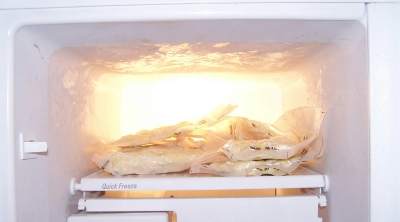
Tips:
- Harvest early in the morning, especially if the weather is hot, to get peak flavor.
- Harvest the corn at its peak maturity (milky fluid in the kernels, kernels tender, and not bloated). Immature corn is watery when cooked and over-ripe corn is chewy and doughy.
- Process promptly after harvesting, or keep cooled in the fridge or with ice until then.
Questions and Answers
- Q. I didn't know about the blanching step and I already froze my
corn? Is that dangerous? Should I take the corn out of the freezer and
blanch it and re-freeze it?
No, there is no health or safety problem. Blanching is done to preserve the flavor and sweetness. In fact, if you eat the corn in a matter of weeks, you probably wouldn't notice the difference. It becomes most noticeable (much less tasty and sweet) after months in the freezer, if it hadn't been blanched. - Q. I followed your freezing corn on the cob directions, but, even
after drying it with paper towels, there is still enough water coming out of
the corn that my vacuum food sealer can't seal the bag. Any ideas ?
A. Yup! Just pop the corn into the freeze in an ordinary ziploc bag for about an hour. That will freeze and water droplets that are left on the corn. Then take it out, put it in your vacuum bag and vacuum seal it!
- Q. I froze corn on the cob as per your instructions but when I
unthawed and cooked some it was mushy. How do I cook it? Not sure if I
should cook it frozen or thaw first and how long to cook or heat.
A. That's an inherent problem with frozen corn-on-the-cob. But, it is better with some varieties than others. Silver Queen and many SE varieties have soft kernels. The super-sweets tend to have much firmer kernels that hold up better when frozen! Be careful not over cook the corn when blanching, too! Stick to the recommended times, and get the corn into ice water right afterwards.
Then when you reheat it, just put it into boiling water straight from the freezer. You will want to cook it for the least time it takes to get it hot, which is normally about 5 minutes. Any overcooking, either before freezing or when you are ready to eat it, will make it more mushy.
- Q. My sister brought me sweet corn from California where she just
moved from. She asked the farmer what is the best way to freeze the cobs and
he told her that his family just cut the over-growth and ends and freeze the
whole cob within the cobs and silk. I did this because of the fact it took
her 3 days driving in hot temps outside so I had to do something quick. I
always would clean and remove the silk and then blanch for over 5 minutes
and cool in ice water then I would use the food saver vacuum sealer. By not
blanching will this be harmful to eat after being frozen and vacuum sealed
without blanching?
A. No, there's no health risk; the corn just will not maintain the quality of its flavor and appearance as long in the freezer. It may have noticeably less flavor after weeks rather than months.
-
Q. When freezing sweet corn you say to start counting blanch time when you put cobs in the boiling water then boil for 4 minutes. I know that when I cook corn on the cob I put the cobs in boiling water and it takes 4 to 5 minutes before it starts boiling again, so my question is does the blanch time actually require the water to be boiling?
A. Yes, the temperature ought to be back up to boiling before starting the timer, if it takes more than 1 minute to return to a boil.
There's another problem at work though. If it takes that long (several minutes or more) for the water to get back to boiling, that indicates that the volume of water is too small, relative to the amount of corn added. The corn is cooling the water too much. Those of you who are physicists or thermodynamicists will recognize the problem of enthalpy here. While the water isn't at the boiling point, it's still heating the corn, which may result in loss of flavor and sugar due to overcooking.
The solution is to use a substantially larger pot, or put much less corn in each batch - or both - so the water returns to boiling in a minute or so.
Comments
- Comments from a visitor on September 04, 2009: "Tried your freezing corn on the cob. EXCELLENT, EXCELLENT. EXCELLENT. I have tried numerous methods from the dishwasher to a number of others. I followed your step by step process, the results a few days later were will EXCELLENT.
Looking for canning equipment and supplies?
Water bath canner with a jar rack
Pressure canners for gas, electric and induction stoves: Presto 23Qt or T-fal 22Qt
Canning scoop (this one is PERFECT)
Ball Blue book (most recent version)
Jars: 8oz canning jars for jams
Find Other types of farms:
Farm markets and roadside stands
Road trips and camping resources
Local Honey, apiaries, beekeepers
Consumer fraud and scams information
Home canning supplies at the best prices on the internet!
Maple Syrup Farms, sugarworks, maple syrup festivals
Environmental information and resources
Farms For Your Event for birthday parties, weddings, receptions, business meetings, retreats, etc.
Festivals - local fruit and vegetable festivals
Get the
most recent version of
the Ball Blue Book
With this Presto 23 quart pressure canner and pressure cooker, you can "can" everything, fruits, vegetables, jams, jellies, salsa, applesauce, pickles, even meats, soups, stews. Model 01781

You can make jams, jellies, can fruit, applesauce, salsa and pickles with water bath canners, like this Granite Ware 12-Piece Canner Kit, Jar Rack, Blancher, Colander and 5 piece Canning Tool Set

